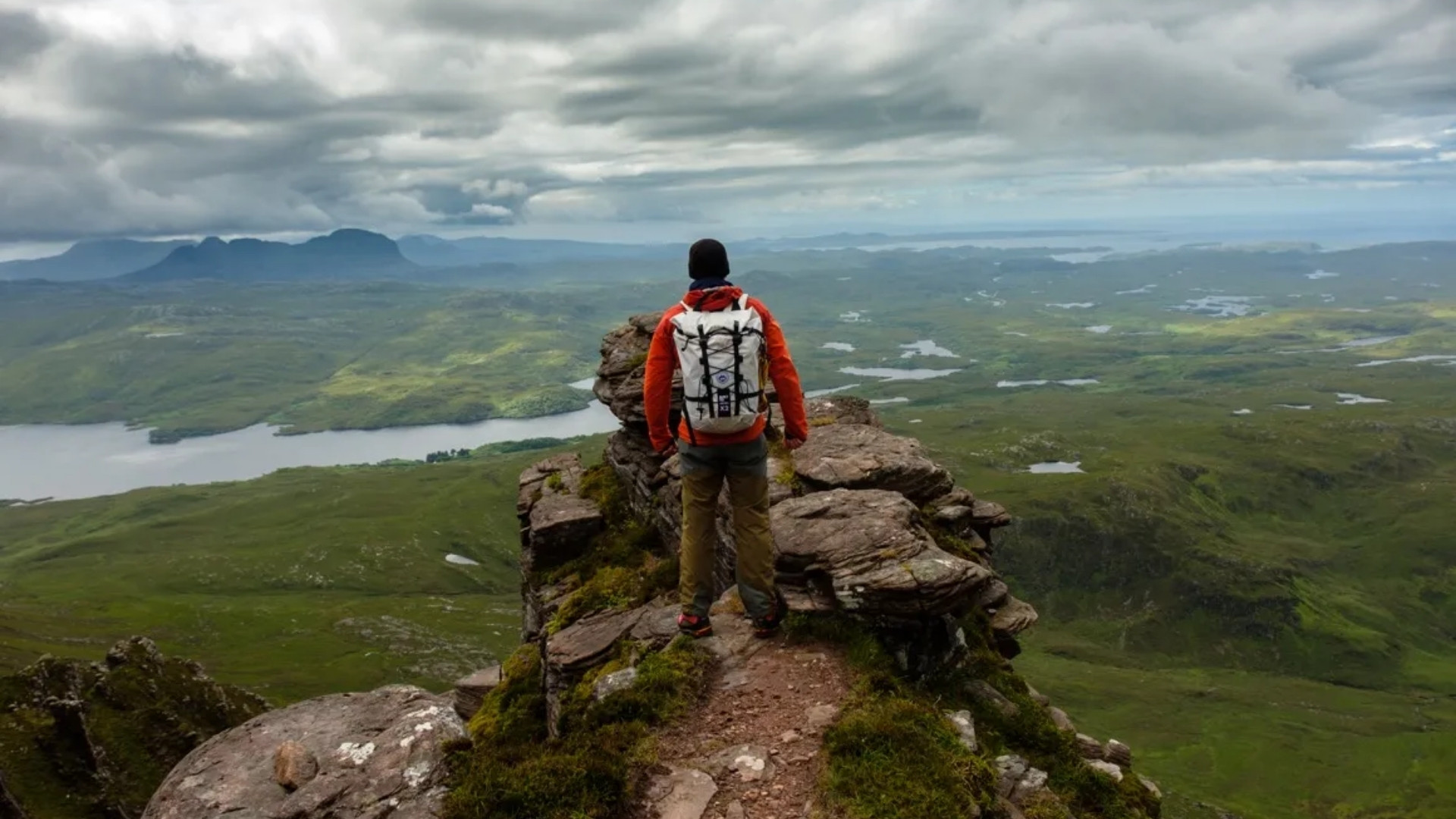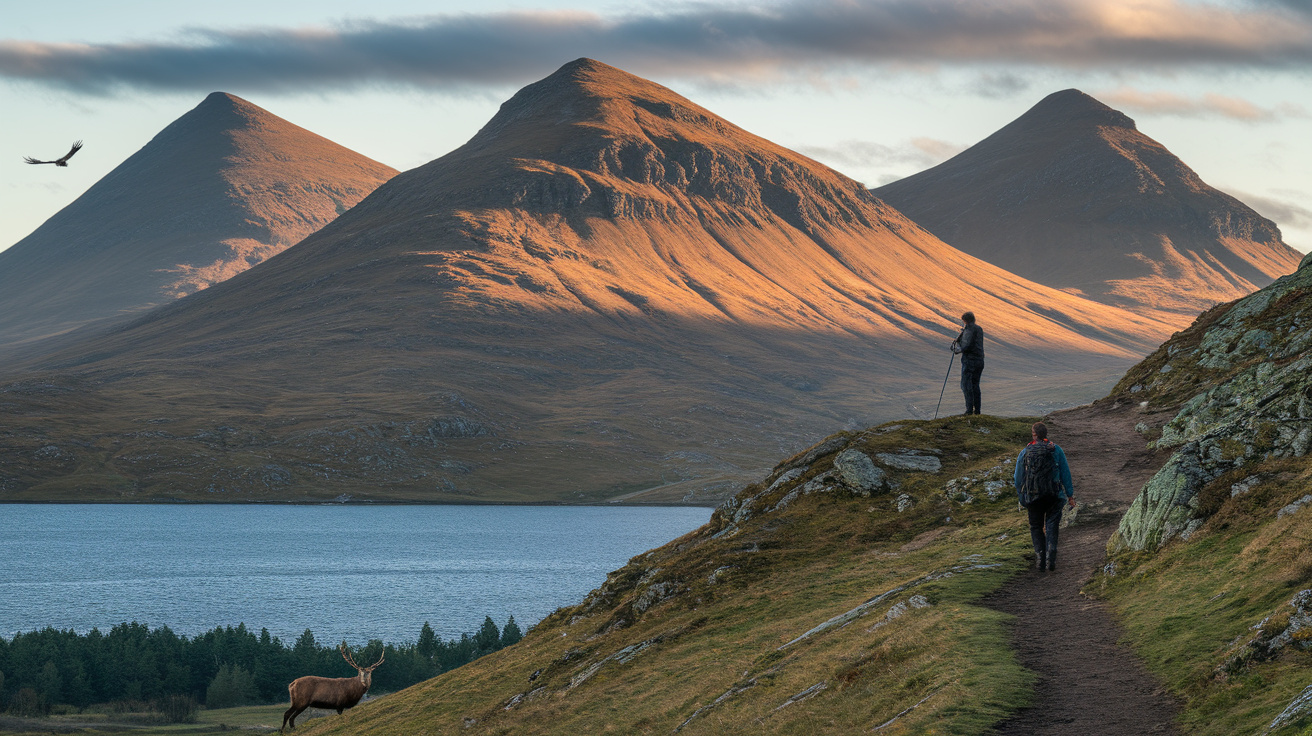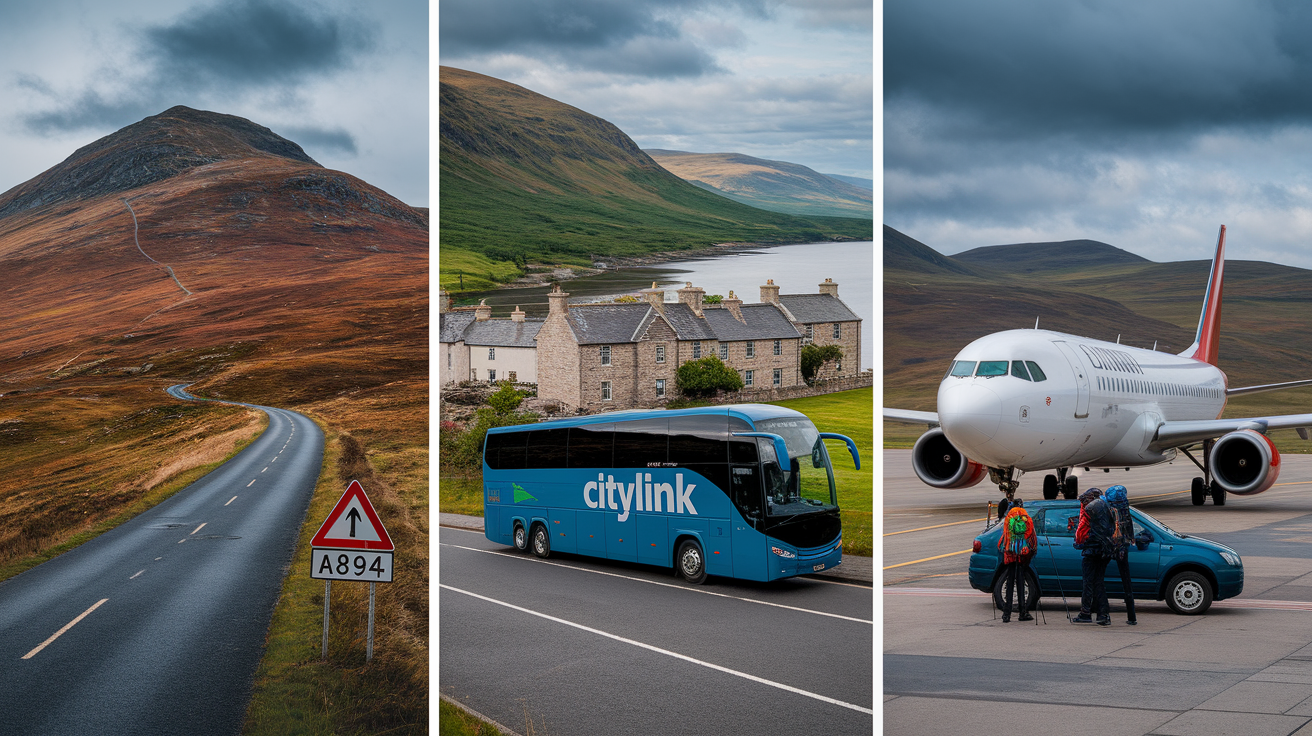Far in the Scottish Highlands, a tall and wild mountain called Quinag waits for people who love hiking and nature.
Its long ridge has three high peaks and gives amazing views of lakes, cliffs, and faraway islands in every direction.
Many hikers say Quinag is one of the best places in Scotland for peaceful walks and beautiful mountain adventures.
It is quiet, not too crowded, and has paths for both strong hikers and those who want easier trails.
If you enjoy exploring, seeing wildlife, or taking pictures of wide open land, Quinag is the perfect place to visit.
Ready to find out what makes this Highland mountain so special?
Let’s learn why Quinag is a top place for hikers.
What is Quinag? A Highland Gem in Scotland
Quinag is a big mountain ridge in northern Scotland, covering 9,140 acres (3,699 hectares) of wild land.
It has three tall hills called Corbetts, each between 2,500 and 3,000 feet (762–914 meters) high.
The highest hill is Sàil Gharbh, also called Rough Heel, at 2,651 feet (808 meters).
Sàil Ghorm, called Blue Heel, is 2,546 feet (776 meters) tall.
Spidean Coinich, called Mossy Peak, is 2,507 feet (764 meters) high.
Quinag is made of very old rocks called Lewisian Gneiss, with layers of sandstone and a top of quartzite.
The land has heather, grass, peat bogs, and some old trees like birch and oak.
Quinag is cared for by the John Muir Trust and is part of the North West Highlands Geopark.
Top Reasons to Hike Quinag

Quinag stands among Scotland’s finest mountain experiences, offering countless rewards for those willing to explore its slopes.
Here’s why it deserves a spot on your hiking bucket list:
1. Unique Triple-Peak Profile
Quinag is special because it has three peaks along one long mountain ridge.
Instead of one summit, hikers can enjoy three different high points in a single hike.
Each peak has its own look.
Some parts are rocky, others are grassy, with views changing as you go.
This makes the trail more exciting and full of variety for people who enjoy a full day in the mountains.
2. Spectacular Panoramic Views
From Quinag’s summits, you see the Isle of Lewis to the west, Sutherland’s peaks to the north, and many lochs to the south.
On clear days, the views stretch for miles, showing Scotland’s wild northern beauty.
3. Less Crowded Than Famous Neighbors
Nearby mountains like Suilven are busier, but Quinag gives you great scenery with more peace and quiet. You might have the mountain almost to yourself, even in peak season.
4. Accessible Starting Point
Quinag’s trailhead starts at 820 feet (250 meters) above sea level.
The car park on the A894 gives easy access to good paths.
5. Abundant Wildlife Viewing
Quinag is a peaceful place with rugged hills, gentle slopes, and quiet woods. It’s perfect for hiking, exploring, and enjoying wide open views.
Planning Your Hike In Quinag

To hike Quinag’s stunning ridge in Scotland, begin with Sàil Gharbh, the highest Corbett, for panoramic views of the rugged Assynt landscape.
Start your trek at the Lochan Bealach Cornaidh car park, following a well-defined trail to Sàil Gharbh.
Next, loop to Sàil Ghorm for a shorter yet rewarding climb.
Finish with Spidean Coinich, known for its picturesque mossy terrain.
This circuit spans 8-10 miles (13-16 km) and takes 6-8 hours, so begin early to ensure daylight for a safe descent.
Preparations to Do Before Starting Your Hike
Proper preparation is key for a safe and enjoyable Quinag hike.
- Check Weather: Review Sutherland forecasts and John Muir Trust trail updates.
- Pack Gear: Wear sturdy boots, bring waterproofs, and carry a map (OS Landranger 15) with compass/GPS.
- Ensure Safety: Share your route and return time, pack a first-aid kit, and carry a charged phone.
- Bring Supplies: Take 2 liters of water and high-energy snacks for the 6-8 hour trek.
- Assess Fitness: Be ready for a strenuous 8-10 mile (13-16 km) hike with steep climbs.
With these steps, you’re set to tackle Quinag’s Corbetts safely.
How to Get to Quinag: Trailhead Directions & Travel Tips

Quinag sits in a remote part of the northern Scottish Highlands, requiring some planning to reach.
Here are the various transportation options to get you to this magnificent mountain.
| MODE | ROUTE / KEY TRANSFERS | TRAVEL TIME | NOTES |
|---|---|---|---|
| Road | Drive via A835 → A837 → A894 to trailhead | ~2.5 hrs from Inverness | Car park (~15 cars); single-track roads |
| Public Transport | Train to Inverness → Bus to Ullapool → Local bus/taxi to Skiag Bridge | Variable: plan for delays | No direct service to the trailhead; limited buses; taxi/walk needed; possible overnight stay |
| Air | Fly to Inverness (best) or Stornoway → Drive to the trailhead | Inverness: ~2.5 hrs; Stornoway: ferry + drive | Closest airports; car hire essential |
One thing to note is that there is no direct public transport to the Quinag trailhead.
The nearest you can get is Skiag Bridge, but you will need to walk or arrange a taxi from there.
Now you know the ways to reach Quinag, so choose the one that fits your time, budget, and comfort best.
Tips for First-Time Hikers at Quinag

Planning your first hike on Quinag requires preparation to ensure a safe and enjoyable experience.
Here are essential tips for tackling this magnificent Highland mountain:
- Check the Weather First: Always check MWIS or Met Office forecasts for the Northwest Highlands. Avoid hiking in poor weather.
- Dress and Pack for the Elements: Wear sturdy boots and pack waterproofs, warm layers, gloves, a hat, food, and 2L of water.
- Start Early: Begin before 9:00 AM to ensure daylight and catch clear summit views before clouds build up.
- Pick a Suitable Route: Beginners should try Spidean Coinich. The full circuit suits experienced hikers only.
- Bring Navigation Tools: Carry OS Explorer 442 and a compass. GPS apps help, but don’t rely on the mobile signal.
- Tell Someone Your Plan: Share your hiking route and return time. Solo hikers should check in after finishing.
- Respect the Environment: Follow Leave No Trace. Take all trash, stay on trails, and avoid disturbing wildlife or plants.
These preparations ensure you can focus on enjoying Quinag’s landscapes without facing unexpected challenges.
Wrapping It Up
Quinag is one of Scotland’s finest mountain experiences, blending challenge, beauty, and solitude in the remote Highlands.
You can hike the full ridge over all three peaks or choose a shorter route to one summit.
Both options offer amazing views and an unforgettable Highland experience.
Before visiting, check the weather forecast, pack smart, and allow plenty of time to enjoy your hike. Stay on marked paths and follow Leave No Trace to help protect this special landscape.
Now it’s your turn to make lasting memories here. Planning a trip? Use our guide to explore Quinag safely and responsibly.
Frequently Asked Questions (FAQs)
Planning a trip to Quinag? Here are answers to some common questions to help you prepare.
What is the Best Time to Visit Quinag?
May to September offers the best weather and longest daylight. June and July are ideal for clear trails and fewer midges.
Where Can You Stay Near Quinag?
Stay in Lochinver for B&Bs and cottages. Wild camping is allowed if done responsibly.
Campsites are also nearby.
What is a Basic Itinerary for Visiting Quinag?
Here’s a basic itinerary you can follow to visit Quinag.
Day 1: Arrive and explore local sights.
Day 2: Hike Quinag (half or full-day option).
Day 3: Relax or visit nearby nature spots before leaving.




